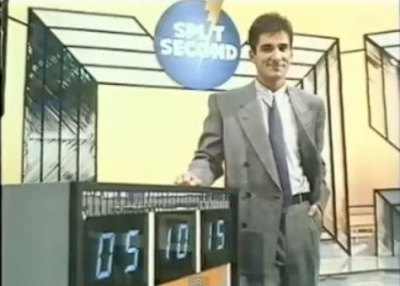Split Second (1)
(→Broadcast) |
|||
| (One intermediate revision not shown) | |||
| Line 6: | Line 6: | ||
== Broadcast == | == Broadcast == | ||
| - | Scottish (not networked), 24 December 1987 to 15 March 1988 | + | Scottish Television (not networked), 24 December 1987 to 15 March 1988 |
</div> | </div> | ||
| Line 41: | Line 41: | ||
[[Category:Regional]] | [[Category:Regional]] | ||
[[Category:Scotland]] | [[Category:Scotland]] | ||
| - | [[Category: | + | [[Category:STV Productions]] |
[[Category:Information Needed]] | [[Category:Information Needed]] | ||
Revision as of 04:33, 10 June 2020
Synopsis
Quiz show with a £1000 top prize, and Paul Coia's first stint as questionmaster.
Art Begotti tells us...
IF (and I use big ol' capitals on that) this version turns out to follow the same rules as the American/Canadian versions (and judging by the fact that the logo in the picture looks similar to the Canadian version and came from the same time period, it probably is), here's a quick rundown of the rules.
- A question with three parts is asked, usually in the form of "Pick one of these three related sub-questions off the board", though there were occasionally questions that were simply listing items. The first person to buzz in would get to pick the first sub-question to answer (or give the first answer for the list question). The second player to buzz would have to pick one of the remaining sub-questions to answer (or choose to take up the first person's question if they were wrong), and the slowest buzzer would get whatever was left unanswered. If they all answered their questions correctly, they'd each get a small amount of cash, but if only one person is right in a question set, they get a comparatively larger reward (say, $5 each if all three are right, $10 each if two are right, but $25 to a lone correct answer). Ask a bunch of questions in round one, double their value for round two.
- The third round, called the "Countdown Round," starts by assigning a number of questions to answer to each player, depending on their score after the first two rounds. The player with the most money has to answer only 3 (later 4) questions in this round to win the game, while the second-place player has to answer an extra question and the last-place player has to answer two extra. The same formats of questions are asked again, but this time, the first buzzer may keep answering questions until they miss, with the second and third buzzers getting the same option if there are any questions left for them. The first to answer their required number of questions (or rather, answer enough questions to countdown to zero) won the game.
- The bonus games in the US/Canadian versions were played for a car, and basically involved the champion getting a one-in-five shot at winning. It's sort of tragic to see a main game built on rapid-fire trivia and some subtle strategy devolve to a game of pick-a-number in the end, but then again, it's cheap suspense that only requires a payout 20% of the time, or something like that.
- If there are any differences I could suggest between our versions and the version to be detailed on this page, I notice that this entry talks about a 1000 pound prize. Considering this, and also that the contestant podiums pictured above (assuming that's the contestant podiums) look like they're more suited to hold a two-digit number, the front game was probably played for points instead of cash. I'd have no clue how the bonus game would've been played, unless it was the same one-in-five game.
Thanks, Art! And if anyone can fill us in on the bonus game (or any other differences), please get in touch.
Inventor
Most likely based on the US format created by Monty Hall and Stefan Hatos.
Catchphrases
A sort of visual catchphrase: whenever Paul mentioned the show's name he would make a slashing gesture with his hand like a flash of lightning. Or like the show's logo, in fact.


